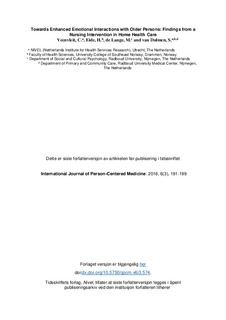| dc.contributor.author | Veenvliet, Charlotte | |
| dc.contributor.author | Eide, Hilde | |
| dc.contributor.author | de Lange, Martijn | |
| dc.contributor.author | van Dulmen, Sandra | |
| dc.date.accessioned | 2017-09-18T10:38:47Z | |
| dc.date.available | 2017-09-18T10:38:47Z | |
| dc.date.created | 2016-09-23T08:39:50Z | |
| dc.date.issued | 2016 | |
| dc.identifier.citation | The International Journal of Person Centered Medicine. 2016, 6 (3), 191-199. | nb_NO |
| dc.identifier.issn | 2043-7730 | |
| dc.identifier.uri | http://hdl.handle.net/11250/2455078 | |
| dc.description.abstract | Background. Living at home with a physical condition that requires assistance places high emotional burden on older persons that needs to be attended to by nurses. However, nurses in home health care have previously been found to communicate primarily in an instrumental way. This increases the risk that emotional concerns are being overlooked or not responded to in an appropriate way. Aims and Objectives. To enhance emotional interactions with older clients in home health care, an individual feedback intervention was developed for these nurses. The first experiences and results are presented in this paper. Design and Methods. Ten nurses/nurse assistants participated in this exploratory pre-post test study. They were asked to audiotape visits with older persons (65+) before and after an audio-feedback intervention. Older clients’ implicit and explicit expressions of emotional concerns as well as nurses’ responses to these expressions were rated with the Verona Coding Definition of Emotional Sequences (VR-CoDES). The nurses were given feedback based on the audio-recordings and the observations and were asked to reflect on the audio-feedback intervention. Results. The nurses valued the audio-feedback. Overall, 201 cues and 35 concerns were expressed during 58 recorded visits. At post-intervention, 29% of identified cues and concerns were nurse-initiated, at pre-intervention 18.8% (NS). Nurses provided space in 73.7% of their responses. During shorter visits nurses tended to provide less space (p=.06). After the intervention, 20.9% of the cues and concerns were ignored, before the intervention this was 25% (NS). Conclusions. Receiving feedback was taken in very well by the nurses working in home health care and the feedback intervention seems to enhance emotional interactions in home health care with older persons. Although, due to the low power of the study, the differences between pre-and post-intervention measurements were not significant. Studies with larger samples are needed to replicate these findings. | nb_NO |
| dc.language.iso | eng | nb_NO |
| dc.title | Towards enhanced emotional interactions with older persons : findings from a nursing intervention in home health care | nb_NO |
| dc.type | Journal article | nb_NO |
| dc.type | Peer reviewed | nb_NO |
| dc.description.version | acceptedVersion | nb_NO |
| dc.source.pagenumber | 191-199 | nb_NO |
| dc.source.volume | 6 | nb_NO |
| dc.source.journal | The International Journal of Person Centered Medicine | nb_NO |
| dc.source.issue | 3 | nb_NO |
| dc.identifier.doi | 10.5750/ijpcm.v6i3.574 | |
| dc.identifier.cristin | 1384483 | |
| dc.relation.project | Norges forskningsråd; 226537 | nb_NO |
| cristin.unitcode | 222,90,3,0 | |
| cristin.unitname | Institutt for sykepleievitenskap - Drammen | |
| cristin.ispublished | true | |
| cristin.fulltext | postprint | |
| cristin.qualitycode | 1 | |
